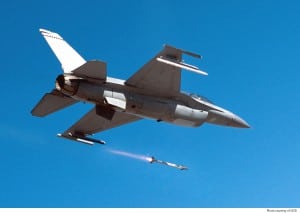The first AIM-9X Sidewinder missile fired from an F-16 fighter jet on Sunday to take down an unidentified high-altitude object over Lake Huron on Sunday missed the target, a top U.S. defense official confirmed Tuesday.
Army Gen. Mark Milley, chairman of the Joint Chiefs of Staff, noted the second Raytheon Technologies-
built AIM-9X fired from the F-16 successfully took down the object, while the first missile landed in the water.

“On the [object] over Lake Huron, the first shot missed. The second shot hit,” Milley said during a press briefing in Brussels following the latest meeting of the Ukraine Defense Contact Group. “In this case, the missile landed harmlessly in the water of Lake Huron. We tracked it all the way down. And we made sure that the airspace was clear of any commercial or civilian or recreational traffic.”
The AIM-9X has been used to take out all four high-altitude objects the U.S. has detected recently, to include the Chinese surveillance balloon shot down off the coast of South Carolina on Feb. 4 and the two other unidentified objects brought down off the coast of Alaska and in the Yukon territory of Canada last Friday and Saturday respectively.
The first three shootdown efforts used F-22s to fire the missiles, while the AIM-9X missiles on Sunday were fired from an F-16.
“Maintaining a radar track on an object this small is very hard. So taking a radar shot such as AIM-120 [AMRAAM, also built by Raytheon] would be a lower probability of success. We assessed taking a gunshot [on Saturday] in that event, as well as [on Sunday]. And the pilots in each situation felt that that was really unachievable because of the size, especially [on Saturday] in the altitude, and also because of the challenge to acquire it visually because it’s so small,” Air Force Gen. Glen VanHerck, commander of USNORTHCOM and North American Aerospace Defense Command (NORAD), told reporters on Sunday. “It’s also potentially a safety of flight issue because you have to get so close to the object before you see it that you potentially could fly into the debris or the actual object. Therefore, in each situation, the AIM-9X, a heat seeking missile or infrared missile that sees contrast, has been the weapons of choice against the objects we’ve been seeing.”
While operations to recover debris from the Chinese surveillance balloon have been ongoing, National Security Council spokesperson John Kirby said Tuesday it “could be some time before we locate and recover the debris” from the three unidentified objects shot down since Friday.
“Obviously, getting access to the debris [for] all three, certainly, will be of immense value in terms of our ability to positively identify what these objects were and what their purpose was. So we’re going to continue those intensive recovery efforts because they’re important,” Kirby told reporters during a briefing.
Milley noted the difficulty ahead in retrieving the debris due to the terrain where the objects were shot down.
“They are in very difficult terrain. The second one off the coast of Alaska, that’s up in some really, really difficult terrain in the Arctic Circle with very, very low temperatures in the -40’s. The [third] one is in the Canadian Rockies in the Yukon. It’s very difficult to get that one. And the [fourth] one is in Lake Huron at probably a couple hundred feet depth. So we’ll get them eventually but it’s going to take some time to recover those,” Milley said.
Kirby and several DoD officials have said the uptick in detection of high-altitude objects intruding into U.S. airspace, to include three such objects shot down since Friday, may be due to recent radar enhancements that have allowed for greater scrutiny of such events (Defense Daily, Feb. 13).
Kirby noted there are no indications yet that the three most recent objects are a part of China’s surveillance program, while adding that no entity has come forward to claim ownership.
“While we can’t definitely say, again without analyzing the debris, what these objects were, thus far, and I caveat that by saying thus far, we haven’t seen any indication or anything that points specifically to the idea that these three objects were part of [China’s] spy balloon program or that they were definitively involved in external intelligence collection efforts,” Kirby said. “[The intelligence community] will not dismiss as a possibility that these could be balloons that were simply tied to commercial or research entities and therefore [were] benign. That very well could be or could emerge as a leading explanation here.”
The Pentagon confirmed last week the Chinese surveillance balloon that was shot down, along with three such incidents during the Trump presidency and another balloon incursion into U.S. airspace earlier in the Biden administration, was part of a larger surveillance program run by Beijing (Defense Daily, Feb. 8).
“All we’re doing is speaking the truth. And the truth is this is a well-funded, deliberate program by the Chinese to collect intelligence on other nations, clearly, including us,” Kirby said on Tuesday. “The reason we know that is because of the work we’ve done since we came into office to better understand this program and to try to do the kind of deep analytical work that needed to be done to decipher how these balloons operate and how we can best detect and track them.”